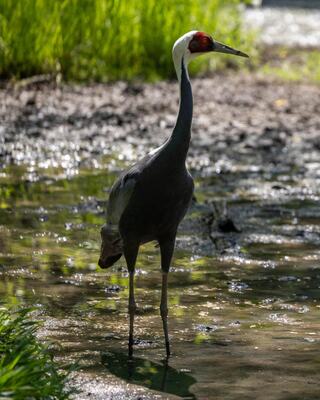
White-Naped Crane
The white-naped crane is a striking bird native to the grasslands and wetlands of eastern Asia. It breeds in regions along the borders of Russia, Mongolia, and China, and migrates south for the winter, spending the colder months in southern China, Japan, and even the demilitarized zone (DMZ) between North and South Korea. These cranes are easily recognized by their elegant gray bodies and the distinctive white band of plumage that stretches from the nape of the neck up to the back of the head, giving the species its name.
In the wild, white-naped cranes forage for a variety of foods, including seeds, roots, insects, and even small vertebrates. Unfortunately, their numbers have dropped significantly over the years. With only about 6,500 individuals remaining, they are currently classified as vulnerable. Major threats include habitat loss—particularly the conversion of wetlands into farmland—and hunting. In response, the Good Zoo is proud to be part of the White-Naped Crane Species Survival Plan, a collaborative effort among accredited zoos to help ensure this species has a secure future.
At the zoo, we care for a pair of white-naped cranes named Barry and Pi. They are fed a specialized zoo crane pellet, along with oats and cracked corn to support their nutritional needs. For enrichment, Barry and Pi enjoy thawed pinky mice, smelt, and especially probing through their habitat in search of insects and larvae—a behavior that mimics their natural foraging and keeps them mentally and physically engaged.
If you visit our zoo, you might catch a glimpse of Barry and Pi gracefully exploring their habitat or showing off their curious personalities as they search the ground for tasty treats.